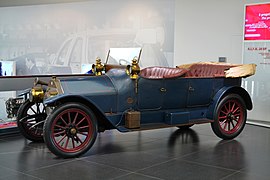
Giovanni Michelotti was one of the most prolific designers of sports cars in the 20th century. His notable contributions were for Ferrari, Lancia, Maserati and Triumph marques. He was also associated with truck designs for Leyland Motors, and with designs for British Leyland after the merger of Leyland and BMC.

Gruppo Bertone, commonly known as Bertone, was an Italian industrial design company which specialized in car styling, coachbuilding and manufacturing. It formerly was also a car manufacturing company. Bertone styled cars for Abarth, Alfa Romeo, Aston Martin, BMW, Citroën, Ferrari, FIAT, Iso, Lancia, Lamborghini, Mercedes-Benz, Opel, and Volvo, among others. In addition, the Bertone studio was responsible for two of the later designs of the Lambretta motorscooter.
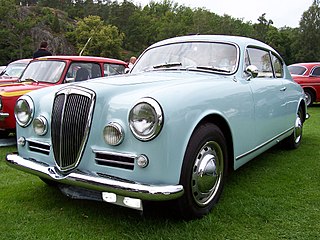
A grand tourer (GT) is a type of car that is designed for high speed and long-distance driving, due to a combination of performance and luxury attributes. The most common format is a front-engine, rear-wheel-drive two-door coupé with either a two-seat or a 2+2 arrangement. Grand tourers are most often the coupé derivative of luxury saloons or sedans. Many iconic car models, such as the Ferrari 250 GT, Jaguar E-Type, and Aston Martin DB5, are considered classic examples of gran turismo cars.

Zagato is a coachbuilding company. The design center of the company is located in Terrazzano, a village near Rho, Lombardy, Italy.
Vignale is the luxury car sub-brand of Ford Motor Company used in automobiles sold in Europe. The former company Carrozzeria Alfredo Vignale was an Italian automobile coachbuilder established in 1948 at Via Cigliano, Turin, by Alfredo Vignale (1913–69). After its founder's death in 1969, Carrozzeria Vignale was acquired by De Tomaso. The studio ceased operation in 1973, but ownership of the name was taken over by Ford Motor Company.

Carrozzeria Ghia SpA is an Italian automobile design and coachbuilding firm, established by Giacinto Ghia and Gariglio as "Carrozzeria Ghia & Gariglio". The headquarters are located at Corso Guglielmo Marconi, 4, Turin. The company is currently owned by Ford Motor Company and focused on the European market through Ford's subsidiary in the region.
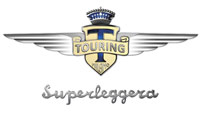
Carrozzeria Touring Superleggera is an Italian automobile coachbuilder. Originally established in Milan in 1925, Carrozzeria Touring became well known for both the beauty of its designs and patented superleggera construction methods. The business folded in 1966. In 2006 its brands and trademarks were purchased and a new firm was established nearby to provide automotive design, engineering, coachbuilding, homologation services, non-automotive industrial design, and restoration of historic vehicles.

Aurelio Lampredi was an Italian automobile and aircraft engine designer.

Superleggera is a custom tube and alloy panel automobile coachwork construction technology developed by Felice Bianchi Anderloni of Italian coachbuilder Carrozzeria Touring Superleggera. A separate chassis was still required.
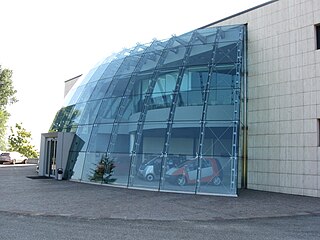
Pininfarina S.p.A. is an Italian car design firm and coachbuilder, with headquarters in Cambiano, Turin, Italy. The company was founded by Battista "Pinin" Farina in 1930. On 14 December 2015, the Indian multinational giant Mahindra Group acquired 76.06% of Pininfarina S.p.A. for about €168 million.

The automotive industry in Italy is a quite large employer in the country, it had over 2,131 firms and employed almost 250,000 people in 2006. Italy's automotive industry is best known for its automobile designs and small city cars, sports and supercars. The automotive industry makes a contribution of 8.5% to Italian GDP.
Carrozzeria Allemano was an automobile coachbuilder in Turin, Italy, owned by Serafino Allemano.

The Isotta Fraschini Tipo 8A is a luxury car made by the Italian manufacturer Isotta Fraschini from 1924 until 1931. It was the successor to the Tipo 8 model, with a new 7.3-litre straight-eight engine to replace the 5.9-litre unit used in the previous model. This new engine could produce 115–160 metric horsepower (85–118 kW). This was the most powerful mass-produced straight-8 engine in the world at that time. The Tipo 8A was offered only with bare chassis and engine for the coachbuilders.

Carrozzeria Boneschi S.r.L. is an Italian coachbuilder, mainly of commercial vehicles. Until 1960, the company was mostly involved with automobile manufacturers such as Talbot, Rolls-Royce, Alfa Romeo, Lancia and Fiat. It was established in Milan by Giovanni Boneschi, moving to Cambiago in (1933). The factory was rebuilt after World War II (1946), after which Boneschi died. Among its designers and directors in the later years was Dr. Bruno Pezzaglia. Boneschi brand has recently been acquired by the coachbuilder Savio.

The Isotta Fraschini Tipo 8 is an Italian luxury car made between 1919 and 1924.

Carrozzeria Motto was an Italian (Turin) coachbuilding company established in 1932 by Rocco Motto. The company produced bodies from Cadillacs to Delahayes. In 1946 Motto commenced building aluminium bodies for Alfa Romeo, Fiat, Cisitalia, Bandini and Ermini. During 1963, Motto made a body for a Franco Scaglione-designed Porsche-Abarth 356 Carrera GTL berlinetta. He also bodied a handful of Ferraris.
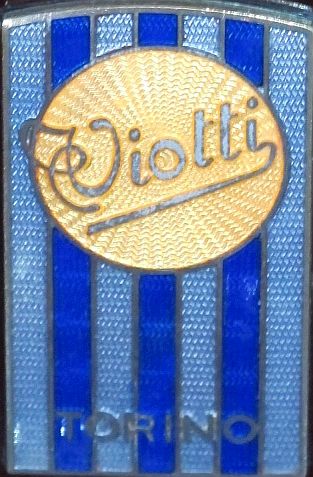
The Carrozzeria Viotti was an Italian coachbuilding company active between 1921 and 1964. The company was founded in Turin, Italy by Vittorio Viotti. Designers like Frua and Mario Revelli worked for the company. It was the first coachbuilding company in Italy to set up a proper production line.

The Milanese coachbuilder Carrozzeria Colli was established by Giuseppe Colli in 1931 and included his four sons, Mario, Candido, Beniamino and Tarcisio. The company was specialized in using aluminium its works. The first automobiles it made were racing cars using Fiat 1100 mechanicals and chassis, also Fiat 500, Lancia Astura and Aprilia were used as basis. During the World War II the company worked for airforces and after the war made car bodies. After the war they made couple of Alfa Romeo 6C 2500SS, Lancia Aprilia based cars and for the 1947 Villa d'Este a Fiat 500 barchetta.

The Alfa Romeo Portello Plant in Portello Milan, Italy was the first Alfa Romeo factory, and the main factory between 1908 and the 1960s. The factory was closed in 1986 following FIAT's buyout of Alfa Romeo, but all major production had already been transferred 20 years earlier to the Alfa Romeo Arese Plant. The history of the factory is primarily involved in automobile manufacture, but over the years other products were manufactured as well.

Carrozzeria Garavini was an Italian coachbuilding company based in Turin, Italy.

